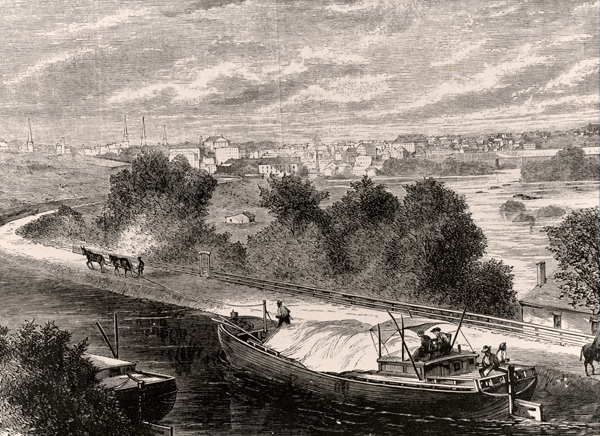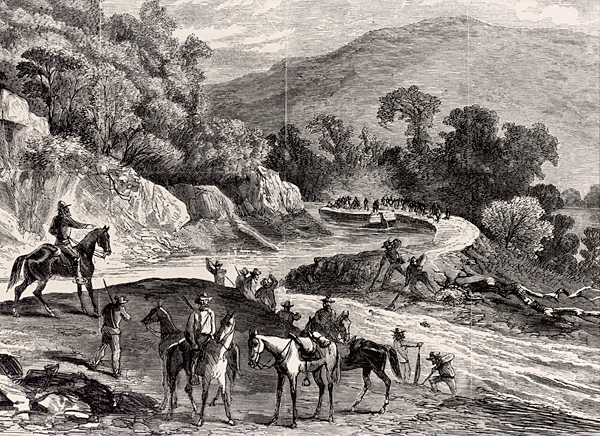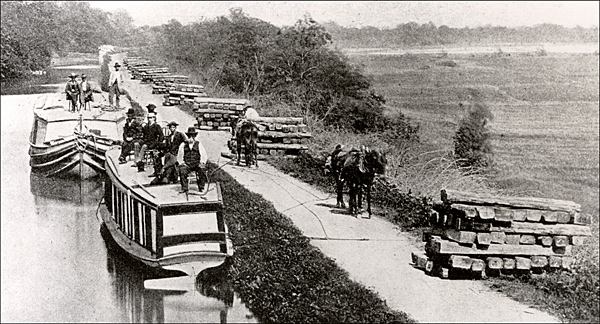

  |
|
|

|
Name: 1865 Report to Stockholders of James River and Kanawha Canal Date: Early 1860's Comments: In the above photo, mules pulled a canal boat along the James River and Kanawha Canal near Richmond, Virginia, in the early 1860's. The canal served as a very successful means of transporting produce from the Lynchburg area all the way to Richmond during the 1840-1880 time period. However, bad weather impacted the canal's operation as did damage to the canal inflicted by Yankee soldiers beginning in June 1864. The meeting of the James River and Kanawha Canal Company on October 23, 1865, was not a happy occasion. Thomas H. Ellis, President of the Board, informed his stock holders that the report of the previous year (1864) was not available. It had been at the printer when the City of Richmond was evacuated, and, in the general confusion was stolen or destroyed. Ellis reported that the year 1864 was "marked by an unusual suspension of navigation, caused by ice" in both January and February. Then in March, "a very high freshet prevailed which caused much damage at various points along the line." Two more freshets occurred in mid-April and June, inundating the tow-path and embankments and creating a breach in a dam on the North River. On the 10th of June, "a detachment of US troops, commanded by Major General Hunter, appeared on the line, burned the gates of the first lock below Lexington, the carpenter's shop, with all the tools, timber, and provisions on hand." This was the first of a series of raids. Despite those troubles, Ellis reported the receipts of the Company for the year ending on 30th of September 1864, amounted to $445,687.03. But unfortunately, this was in Confederate currency, which was by that time seriously depreciated. 1865 was destined to be still worse. It began with more ice and three freshets between January and the end of March, "which submerged nearly the entire line, and caused much damage, washed away the embankments at various points, partially filling up some of the levels with deposits of mud, and forming numerous sand bars in the canal and the channels of the river." This was all before the appearance of Major General Sheridan and his Union troops in March 1865. The damage caused by these soldiers extended over eighty-nine miles of the canal, and included "34 locks and one aqueduct injured, one tow-path bridge and 28 farm bridges burnt, five large breaches in the embankments, one culvert sunk in, four house-boats, two dredge-boats, and one rock boat burnt, two dredge-boats injured, and the workshops and other buildings with tools, provisions, and valuable supplies of timber, at Scottsville and Columbia destroyed."  Cheseapeake and Ohio Canal along the Potomac River in Maryland Sketch showing an unidentified Confederate raiding party cutting the berm bank that confined the canal waters. Similarly, Sheridan's men cut a number of breaches in the James River and Kanawha Canal along the James River. Photo courtesy of Harper's Pictorial History of the Civil War, 1866 Repairs began at once. After the surrender of Appromattox, aid came from the U.S. government, and the canal was finally open in late June 1865. However, many problems remained. A number of canal boats had been confiscated as the property of the Confederate government, a substantial sum of money owed to the Company by the government was clearly not going to be paid, and the victorious government imposed a series of taxes, including "an onerous excise tax." In addition, "the board regrets to report that the condition of the line, especially the upper portion of it is worse than it has been at any time since the completion of the improvement to Buchanan." Delayed maintenance, damage from "natural causes," and a shortage of labor (including "negores enticed or driven away") resulted in large deposits of mud and sand, as well as the deterioration of the infrastructure. In the background loomed the ominous presence of the extending sphere of the railroads, the Orange and Alexandria Railroad, and the Virginia and Tennessee Railroad. The canal limped along for another decade, before rails were laid on the old tow-path, and the era of the canal, at least in Scottsville was over.  JR&K Canal is shown above as the canal boats continued their operation during the last days of the canal in 1880 as the Richmond and Allegheny Railroad (later C&O) began stacking their railroad ties along the canal towpath just before beginning construction of their railroad line. Photo B257cdB25, courtesy of Burgess Collection at Scottsville Museum. As it teetered on the brink of financial failure, the James River and Kanawha Canal Company deeded the canal to the Richmond and Allegheny Railroad in 1880, which began building their track on the old canal towpath. The railroad section through Scottsville was connected with the outside world by modern facilities of transportation and communications. Thanks to Richard L. Nicholas for uncovering this report in his research for his book entitled Sheridan's James River Campaign of 1865 Through Central Virginia. Copyright © 2020 by Scottsville Museum |
|
|
|
Museum
Archive
Business
Cemeteries
Church
Events
Floods
For Kids
Homes
Portraits
Postcards
School
Transportation
Civil War WWII Esmont Search Policy |
||||
|
Scottsville Museum · 290 Main Street · Scottsville, Virginia 24590 · 434-286-2247 www.avenue.org/smuseum · info@scottsvillemuseum.com Copyright © 2020 by Scottsville Museum |
||||